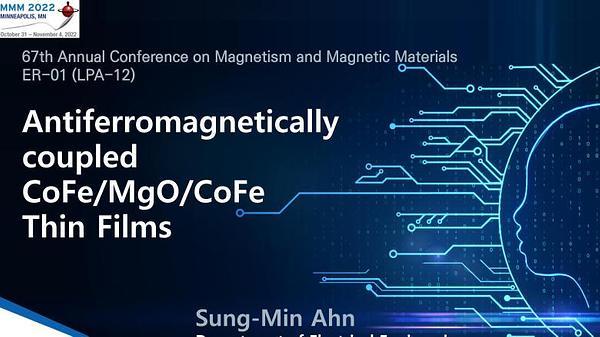Would you like to see your presentation here, made available to a global audience of researchers?
Add your own presentation or have us affordably record your next conference.
Future embedded and standalone magnetic random access memory (MRAM) solutions require materials possessing bulk magnetocrystalline anisotropy at sub-10 nm feature sizes. FePd in its L10-ordered phase delivers MJ/m3 bulk anisotropy energy density (Ku) 1, large interlayer exchange coupling through Ru 2, Gilbert damping (α) below 0.008 3 and robust compatibility across a range of Pt-group buffer layers 4. Transitioning FePd films into mature spintronic applications requires a higher level of process control realize highly uniform microstructural, magnetic and magnetotransport properties.
We demonstrate control of the orientation distribution of the c-axis in highly (001)-oriented L10 FePd. Using direct current magnetron sputtering on (001)-cut, polished MgO substrates, we explore an N2 substrate anneal, variation in the individual thicknesses of the Cr/Pt underlayer and post-anneal modules between layers. Each sample had an 8-nm-thick FePd layer grown at 350 °C and post-annealed at 500 °C, leading to a high degree of L10 ordering, with Ku ranging between 0.8 MJ/m3 and 1.1 MJ/m3 and α ranging from 0.0067 to 0.0133. Despite the relatively narrow spread in these key parameters, we observed a wide range of inhomogeneous linewidth broadening (µ0ΔH0) from ferromagnetic resonance measurements, ranging from below 0.01 T to nearly 0.2 T (Fig. 1(a)). Variation in µ0ΔH0 correlates with the FePd grain orientation distribution, as measured by x-ray diffraction rocking curve scans of the (002) Bragg peak (Fig. 1(b)). Our process controls enable varying the full-width-half-maximum (FWHM) of the (002) peak from 14 degrees down to nearly 2 degrees, leading to narrowing of the local anisotropy distribution and reduction in the µ0ΔH0 (Fig. 1(b) inset). These process improvements will deliver the large-scale uniformity needed to implement FePd-based MRAM solutions.
References:
1 M. Futamoto et al., AIP Advances 6, 085302 (2016)
2 D.-L. Zhang et al., Phys. Rev. Appl. 9, 044028 (2018)
3 D.-L. Zhang et al., Appl. Phys. Lett. 117, 082405 (2020)
4 X. Wang et al., AIP Advances 11, 025106 (2021)

Figure 1: (a) FMR Linewidth versus frequency for three samples with inhomogeneous line broadening of 0.178 T (blue), 0.075 T (green) and 0.015 T (red). (b) Inhomogeneous line broadening versus FWHM of FePd(002) (Δω), with (inset) exemplary FePd(002) rocking curve scans of the red, blue and green star samples highlighted with colored markers in (a)
